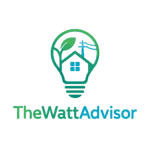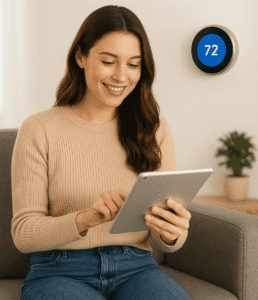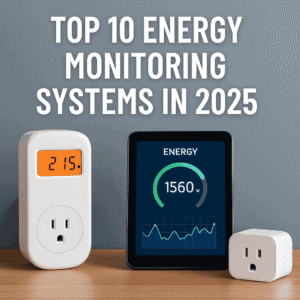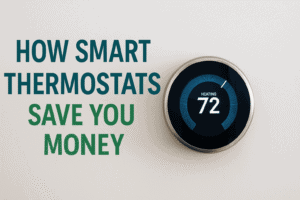Best Smart Home Devices for Energy Efficiency in 2025
In 2025, as energy prices rise and environmental concerns grow, upgrading to smart home devices that enhance energy efficiency is more important than ever. These devices not only offer convenience but also deliver real cost savings by optimizing how and when your home uses energy. In this guide, we’ll explore the top smart home devices of 2025—each selected for its ability to reduce energy waste, integrate smoothly within your home, and deliver meaningful ROI.
By focusing on automation—from boiler control and smart lighting to connected appliances and solar systems—you can turn your ordinary home into a smart, efficient powerhouse. Each featured product comes with detailed pros and cons, pricing insights, and quick compatibility notes. Plus, you’ll find links to related in-depth content:
- Home energy efficiency overview: Ultimate Guide to Home Energy Efficiency
- Smart thermostat deep dive: How Smart Thermostats Save You Money
- Related smart gadgets list: Top 10 Smart Gadgets for Energy Efficiency in 2025
- DIY winter tips: Top 10 Winter Energy Saving Tips
Let’s dive into the best smart home devices making a difference this year.
1. Smart Thermostats
🔥 Google Nest Learning Thermostat
Overview
A pioneer in learning thermostats, the Nest Learning Thermostat adapts to your habits and learns your schedule—providing automatic temperature adjustments that maximize efficiency.
Pros
- Learns behavior and optimizes schedules
- Energy History and Leaf reminders
- Works with Alexa, Google Assistant, and Apple HomeKit via Thread
- Auto-Away mode reduces heat when no one’s home
Cons
- Premium price (around $250)
- Limited geofencing compared to competition
- Requires C-wire for power in some homes
🔥 ecobee Smart Thermostat Premium
Overview
ecobee’s premium model adds built-in occupancy sensors and Air Quality monitoring to its already efficient thermostat line.
Pros
- Includes SmartSensor for room-level comfort
- Supports Apple Home? and Thread
- Offers strong rebates in many regions
- Built-in speaker with Alexa
Cons
- Still needs a C-wire
- Subscription required for smart features like Alexa Guard+
- Slightly bulkier than Nest
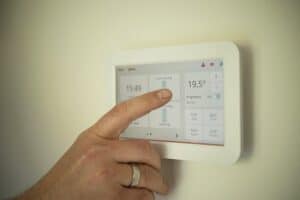
2. Smart Lighting Systems
💡 Philips Hue White and Color Ambiance
Overview
Industry-leading smart bulbs and fixtures with advanced scheduling, color tuning, and energy tracking.
Pros
- Superior app and integrations (Hue Bridge required)
- Works with all smart ecosystems
- Energy-efficient LEDs with dimming and circadian control
Cons
- Higher cost than basic bulbs
- Bridge required for full functionality
- Firmware updates occasionally glitchy
💡 Lutron Caseta Wireless Lighting
Overview
Professional-grade smart dimmers and switches, ideal for hardwired lighting control.
Pros
- Hardphone-grade reliability and manual override
- Excellent local control with no cloud latency
- Works with Alexa, Google, HomeKit, and Sonos
Cons
- Requires professional-like installation
- Separate hub needed
- More expensive than smart bulbs
3. Smart Power Management
🔌 TP-Link Kasa KP115 Smart Plug
Overview
Affordable plug that tracks energy usage and enables scheduling, away mode, and remote control.
Pros
- Cost-effective (<$20)
- Real-time energy reporting
- Works with Alexa and Google
- Scheduling and away mode
Cons
- Only single outlets, not surge protected
- Must be plugged in visibly
- Reports not as granular as energy monitors
🔌 Belkin Wemo Insight Smart Plug
Overview
Tracks energy use and provides cost estimates along with on/off scheduling and IFTTT support.
Pros
- Prompts to reduce energy by tracking usage
- Works with Apple Home? and IFTTT
- Detects device standby
- Auto-off scheduling
Cons
- Slightly slower response time
- Lacks thread/leakage recognition
- Requires stable Wi-Fi
4. Smart Water Heater Control
🚿 Rheem EcoNet Smart Water Heater Controller
Overview
Connects to your gas or electric water heater, offering scheduling, usage data, and leak detection.
Pros
- Schedules to off-peak hours
- Leak detection sensors
- Energy tracking
- Rheem ecosystem integration
Cons
- Limited brand compatibility
- Professional install recommended
- Subscription needed for leak alerts
🚿 Aquanta Smart Water Heater Controller
Overview
Connects via Wi-Fi to electric tank-style water heaters to optimize temperature and reduce standby energy.
Pros
- Easy DIY installation
- App-controlled scheduling
- Energy savings calculation
- Smart notifications
Cons
- Electric heaters only
- Not compatible with PEX protected units
- Basic UI
5. Smart Blinds & Shades
🪟 Lutron Serena Smart Shades
Overview
Automated window shades that integrate with smart systems for light and heat control.
Pros
- Excellent integration (Alexa, Google, Apple)
- Offers solar-ready shades
- Quiet and sleek design
- Solar-tracking automation possible
Cons
- Very expensive ($300+ per shade)
- Requires professional installation
- Needs hub
🪟 IKEA FYRTUR Smart Blinds
Overview
Affordable motorized blinds that work with IKEA Home ecosystem and smart platforms via TRÅDFRI gateway.
Pros
- Budget-friendly (under $200)
- Good coverage options
- Compatible with HomeKit/Google/Alexa via gateway
Cons
- Heavy and needs mounting guide
- Needs IKEA gateway
- Limited shading textiles
6. Smart HVAC Controls
🌬️ Flair Smart Vent & Thermostat
Overview
Automated smart vents that optimize room-level temperature alongside central thermostats.
Pros
- Balances zoned HVAC by room
- Supports Nest, ecobee, or Flair thermostat integration
- Fancy scheduling with heat/cool curves
Cons
- Expensive for full-home setups
- Some ductwork required
- Setup is more complex
🌬️ Honeywell Home T9 Smart Sensor Thermostat
Overview
Delivers room-level temperature and occupancy sensing for whole-home comfort.
Pros
- Budget-friendly
- Includes wireless sensor(s)
- Works with Alexa, Google, HomeKit with hub
Cons
- Sensors need AAA batteries
- App navigation not as intuitive as others
7. Smart Energy Monitors
⚡ Sense Home Energy Monitor
Overview
Connects to your breaker panel for real-time circuit-level usage insights.
Pros
- Identifies energy-hogging devices
- Historical usage data
- Push alerts for abnormal usage
- Alexa and Google integration
Cons
- Professional installation recommended ($200+ just for install)
- Some device recognition is approximate
- Expensive ($300 retail)
⚡ Emporia Vue Smart Home Energy Monitor
Overview
Affordable energy monitor with circuit tracking and retrofit options.
Pros
- Budget choice (~$199)
- Real-time usage data per circuit
- Option to add 8+ sensors
- Works with Alexa/Google
Cons
- DIY installation needs electrical confidence
- App experience less polished
- No solar integration
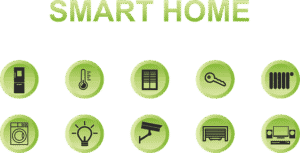
8. Solar & Battery Integration
☀️ Enphase IQ Battery & Microinverter
Overview
Advanced module-level solar inverter with integrated home energy management.
Pros
- Optimizes each panel’s output
- Works with battery storage systems
- Web and app energy insights
- High panel-level efficiency
Cons
- Requires solar installation
- Costly ($10k+ total system)
- Needs specific installers
☀️ Tesla Powerwall 3
Overview
High-capacity home battery designed to support solar and backup power.
Pros
- 13.5 kWh usable storage
- Integration with Tesla solar systems
- Self-powered homes and island mode
- App and Alexa capabilities
Cons
- Very expensive ($10–$12k installed)
- Long waitlists in some regions
- Permitting and grid-agreement delays
9. Smart Outdoor Lighting & Security
🌙 Ring Floodlight Cam Pro
Overview
Combines energy-efficient LEDs with motion/detector lighting and home security.
Pros
- Energy-saving motion activation
- Voice control and security integration
- Cloud storage and solar-ready model
Cons
- Subscription needed for full storage access
- Connects only over 2.4 GHz Wi-Fi
- Solar panel sold separately
🌙 Ring Solar Pathlight
Overview
Low-voltage solar path lights with smart activity sensing and mobile app control.
Pros
- Zero electricity usage
- Auto dim/wake‑up modes
- App notifications
Cons
- Requires sun exposure to charge
- Occasional network dropouts
Choosing the Right Devices for Your Home
A. Start With Impact: HVAC & Lighting
Prioritize smart thermostats, lighting, and power strips—they offer quick ROI and broad energy savings.
B. Expand to Zoning & Monitoring
Add smart vents, sensors, and energy monitors to target inefficiency in specific rooms and appliances.
C. Scale to Renewable & Integrated Systems
Consider solar, battery, and advanced HVAC if your budget and home allow—these offer long-term payback and resilience.
📊 Example ROI Table (estimated payback time):
| Device Type | Cost Estimate | Energy Savings | Payback Period |
|---|---|---|---|
| Smart Thermostat | $150–250 | 10–20% on HVAC | < 2 years |
| LED Smart Bulbs (10-pack) | $100 | 75% less than old bulbs | <1 year |
| Energy Monitor | $200–300 | Detects $100+/yr waste | ≈ 2–3 years |
| Smart Shades | $300–600 each | 5–10% HVAC save | 3–5 years |
| Solar + Battery System | $10k+ | Off-grid + bill reduction | 7–12+ years |
Installation & Compatibility Tips
- Wi-Fi coverage is essential—consider a mesh network.
- Check compatibility: Zigbee, Thread, Z-Wave, Matter become more common.
- Plan for C-wire on thermostats—check HVAC compatibility.
- Prioritize systems that interface easily with Nest/HomeKit/Alexa/Google Assistant.
- Consider pro installation for solar, HVAC vents, and shades.
Rebates & Incentives
- Smart thermostats and energy monitors often receive utility rebates—especially in the U.S.
- Solar systems qualify for the 30% federal ITC and state-level rebates.
- LED lighting and smart devices may have smaller incentives; check DSIRE.org or your local energy authority.
Smart Device Security & Privacy
- Use separate IoT Wi-Fi guest network
- Enable strong passwords and two-factor authentication
- Regularly update firmware
- Examine privacy policies for cloud-based systems
- Disable unnecessary smart features if data collection is a concern
Maintenance & Optimization
- Quarterly check of thermostat filters and motor vents
- Daily review of energy consumption trends via mobile apps
- Firmware updates and system checks monthly
- Device replacement or retrofit as systems age—follow manufacturers’ lifecycle guidance
FAQs
What are the best smart home devices for energy efficiency?
The best smart home devices for energy efficiency in 2025 include smart thermostats (like Nest or ecobee), smart lighting (Philips Hue, Lutron), smart power strips, and whole-home energy monitors (Sense or Emporia), along with smart HVAC vents and water heater controllers.
Do smart home devices really help save energy?
Yes—smart home devices automate energy usage based on occupancy and behavior patterns. Smart thermostats can save 10–20% on heating and cooling, while smart lighting, energy monitors, and devices like smart vents help optimize energy use and reduce waste.
Are smart home devices secure?
Smart home devices are secure when properly configured. Use a guest-network to isolate IoT devices, enable two-factor authentication, update firmware regularly, and choose reputable brands that emphasize privacy policies.
Can I install these devices myself?
Yes—many devices, like smart plugs, bulbs, and thermostats (with a C‑wire) offer DIY installation. More complex upgrades like solar panels or HVAC vents may require professional installers, but smart readings and controls often remain user-friendly.
Final Summary
Upgrading with the best smart home devices in 2025 can significantly lower your energy use, increase comfort, and future-proof your home. Start with smart thermostats, energy-efficient lighting, and plugs—then layer in zoning, sensors, and solar integration when you’re ready. Combine these with routinely updating insulation, optimizing behaviors, and leveraging rebates to maximize savings. With the right plan and tools, a smart, efficient, eco-friendly home that pays for itself is within reach.
